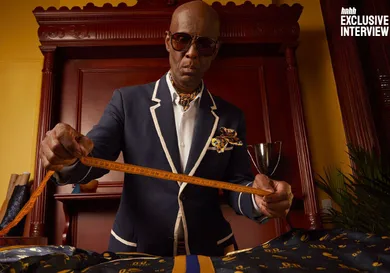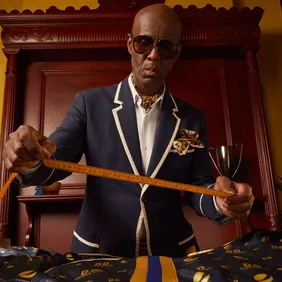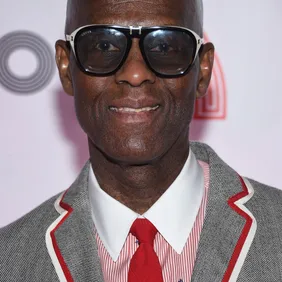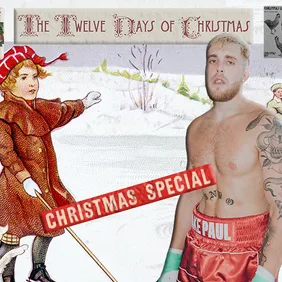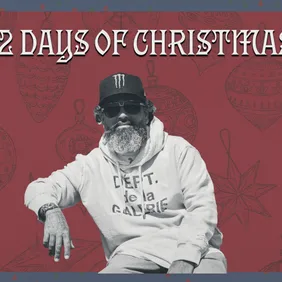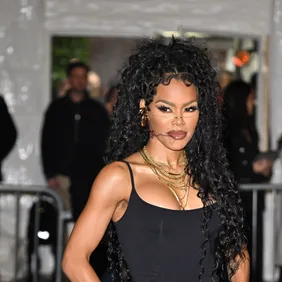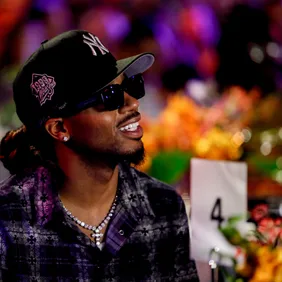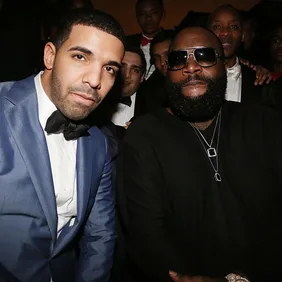Hip-hop's affinity for luxury clothing can largely be traced back to a single figure, Dapper Dan. The father of logo-mania emblazoned "knock-up" Gucci, Louis Vuitton, and Fendi logos for a wide-ranging clientele that included kingpins and hustlers like Alpo Martinez to rappers like Jay-Z and boxers like Floyd Mayweather. However, it was Mike Tyson's infamous fight with Mitch Green in front of Dapper Dan's store on 125th in Harlem on August 24th, 1988 that made headlines on Monday Night Football, turning his local infamy as a streetwear designer into national notoriety. It was at this moment that led Sonia Sotomayor and Fendi to shut his operations down for good.
"It's funny how, at the time when something is happening, it seems like the worst thing, and then it turns out to be the best thing. Like, when Mike Tyson had that fight in my store, there was no more peace left for me. I was forced into the underground because of the attention that I was getting," Dapper Dan told HNHH exclusively.
This past week, Dapper Dan and Pepsi announced their "Made For Football Watching" collection that puts one of the most recognizable logos in the world in the hands of the father of logo-mania, just in time for the NFL Season. It's a full-circle moment for Dapper Dan, who, at one point, gained visibility in the NFL due to his underground operations. "Sotomayor, Mike Tyson, 20 years in the underground, everything that transpired. It's all part of the yellow brick road to get you to the Wiz. You know, so I'm here. And Pepsi is the Wizard of Oz right now," Dapper Dan explained.
Secondly, there's a sentimental value when it comes to the brand since it was also his father's favorite beverage. "When I told my siblings [about the deal], I said, ‘Guess what? Daddy drank so much Pepsi Cola, they gave me a contract,'" he said with a laugh.
Ahead of the launch of the limited edition Dapper Dan x Pepsi Football Watching Capsule Collection, we spoke to the man himself about his history as the "Father Of Logo-mania," the infamous Mike Tyson fight, Michael K. Williams, and so much more.
This interview has been edited and condensed for clarity.
Mark Sagliocco/Getty Images
HNHH: You're somebody who's worked directly with your collaborators -- in terms of rappers, hustlers, sports figures -- when it comes to designing their clothes. How do you approach collaborations with a corporation similarly?
Dapper Dan: Well, you know what, I do that by doing what I do best. Like, I realized that when they come to me, they come to me for a certain element, and that element is me being what they call “the Father of Logo-mania.” So, that gives a brand a lot of depth, you know? So, Pepsi is a super brand already and, you know, I have a profound, strong effect in the subculture. So bringing them two elements together is like a great idea. And right in time for a Fashion Week and the NFL. To have this manifest itself at this time, it's just such a big deal. So, I'm excited about that.
The main thing is you get a chance to see the DD’s with the Pepsi symbol, you know? And I'm all about symbols. This whole thing speaks to exactly what's happening now. So, I'm happy about that.
I was watching your interview on The Breakfast Club where you mentioned how your trips to Africa have deeply inspired your designs in the past. So I was wondering, for this collaboration with Pepsi, what part of African fashion or even culture informed the capsule collection?
Let me tell you something. First, I have to give all due respect to Africa, because had I not gone to Africa, none of this would be happening today. Of course, I travel extensively over Africa, more than 10 countries. And this idea, even unbeknownst to me at the time, was born in Monrovia, Liberia at an African art fair, where they were selling trinkets and everything. And I had an African make me some clothes. From that point, the idea was born. So, I have to be thankful for that.
Now, the connection between the two has always been my search for understanding. That's with history, as well as religion, you know. So, that involved me with symbols. And so in my quest to understand the symbols that define history and religion, I stumbled across the same symbols that was like -- when you look at Islam, Judaism, and Christianity, the symbols are a powerful force, you know what I mean? And then when you look at fashion, fashion was becoming like a powerful force within themselves -- fashion symbols. And I took to that right away. I realized what that was right away. And that's why I embarked on that pathway. So I say, ‘Wow, if I can take these symbols and use them in a way that has never been used before. It used to be like almost giving birth to a new religion,’ you know what I mean?
One thing I found interesting about the fact that you and Pepsi are collaborating for an NFL season capsule collection is that it’s a full-circle moment for you. The infamous Mike Tyson fight that happened outside of your store was broadcasted on Monday Night Football, and that's what ended up getting national attention on your store. How does it feel seeing that connection come full circle the way it has?
Wow, you just raised a great point, right? I was reading the sad story about the guy, Michael K. Williams. The one who played in The Wire. And it's funny how, at the time when something is happening, it seems like the worst thing and then it turns out to be the best thing. Like, when Mike Tyson had that fight in my store, there was no more peace left for me. I was forced into the underground because of the attention that I was getting. With Michael K. Williams, he got slashed across the face. As a result of him getting slashed across the face, he was able to get all these roles as a tough guy and these different things. So sometimes, the message or the omen may not be recognized, you know?
"When Mike Tyson had that fight in my store, there was no more peace left for me. I was forced into the underground because of the attention that I was getting. With Michael K. Williams, he got slashed across the face. As a result of him getting slashed across the face, he was able to get all these roles as a tough guy and these different things. So sometimes, the message or the omen may not be recognized, you know?"
That incident with Mike Tyson and now, coming full circle with me being able to participate in something that's focused towards sports is a great change. And look, who could better talk about you know, NFL and Fashion Week than Dapper Dan and Pepsi, you know what I’m sayin’? [Laughs] So sit up in the game, get your Snuggie on and have a Pepsi.
In retrospect thinking back at that time when that fight happened, it must’ve been a oh shit kind of moment.
No, it was a big shit-type of moment. They raided me. You know how many times I got raided, man? That moment made me famous and it made Sotomayor -- one of the Chief Justice of the Supreme Court. Remember, she was the one who raided me [and] that finally closed me down. It was Fendi, not Gucci. A lot of people attribute it to Gucci. It was Fendi [and] Sotomayor. She was the head lawyer for Fendi, at the time. She paid me a compliment and then did the most detrimental thing that could happen: she shut me down. Took all my machinery. I lost a quarter of a million dollars on that.
"[Sonia Sotomayor] was the one who raided me [and] that finally closed me down. It was Fendi, not Gucci. A lot of people attribute it to Gucci. It was Fendi [and] Sotomayor. She was the head lawyer for Fendi, at the time. She paid me a compliment and then did the most detrimental thing that could happen: she shut me down. Took all my machinery. I lost a quarter of a million dollars on that."
But like I said, it's like -- here’s it in a nutshell. People always ask me this: what would you change about your past if you could? And my answer is: nothing. Because it all led to who I am today. You know, so, Sotomayor, Mike Tyson, 20 years in the underground, everything that transpired. It's all part of the yellow brick road to get you to the Wiz. You know, so I'm here. And Pepsi is the Wizard of Oz right now.
Was there a particular moment after the raid where you had a realization that things would work out in the end for you?
That mental state never took place. My mindset was more about not being broken. You know, not being broken, not giving up. Fortunately, I'm part of the first generation of a family from the Great Migration that came from the South. In fact, my generation is the last generation of African Americans that, across the board, exceeded the accomplishments of their parents. And that's the last time it happened. My generation is the last generation -- let me be clear with you -- my generation is the last generation that exceeded the accomplishments of their parents straight across the board. And then after that, we've been getting to a decline. And there's a reason for that.
All of that energy. I'm the manifestation of all of that energy and I took that to survive, the same way my parents did. My father only went to the third grade and he taught himself how to read. That's why I became such a big reader. And I said that anything I want to learn, I'm going to teach myself.
But that's why I'm teaching myself all about this Pepsi thing and this NFL thing, man. We got to be doing it, man. Bringing Pepsi to Harlem and being a part of this thing, man, it’s a big deal. It's a real big deal, man.
Do you remember the first time seeing the Pepsi logo?
My father drank Pepsi! My father is a Pepsi lover. When I told my siblings [about the deal], I said, ‘Guess what? Daddy drank so much Pepsi Cola, they gave me a contract.’ [Laughs] Yeah, my father was a big Pepsi fan. My father didn't drink or smoke, so Pepsi was his high, you know?
You recently shared a post on Instagram where you stated the most important thing in fashion is translating culture. Coming from a clientele of the flyest hustlers and rappers, how do you take the lessons learned in your early days in Harlem and apply it to the wide-ranging clientele you have now, including Pepsi?
Okay, so this is what happened, right? When I decided to open up the store, I knew I wanted to do luxury. And I knew, from growing up poor with holes in my shoes-- like Goodwill was our Macy's-- I saw and experienced how transformative clothes could be. You could be somebody. If you have the right clothes, and you go someplace, they never know how poor you are. I experienced all of that. So I knew the impact that it would have. So when I decided to open up a store, I said, ‘You know what? I'm gonna sell luxury clothes.’ I said, ‘What is it that we like? We like diamonds. I say, ‘I can't do diamonds, too big of an investment.’ I say, ‘We like minks, leathers, exotic furs’ like that. And that's how I started out. You know, and so what I noticed one day, after a few years of selling exclusively -- you know, leathers and furs and things like that. Silks, like high-end quality things. A guy came into the store, a big-time guy. This was the guy who was directly affiliated with and told on John Gotti’s brother, Gene Gotti. He was my number one customer. You’ll see that in my book, Gene Gotti. He just got out of jail after doing 30 years. But anyway, his name was Jack Jackson. He came into the store with a Louis Vuitton bag pouch full of $100 bills. And everybody got so excited about that pouch. And I said, ‘Wow, if I can make them walk around looking like luggage, I can make a lot of money.’ So, that's when I started reading and teaching myself everything about textile printing.
So what happened? The transformation in luxury moved from diamonds and furs, and silks, and leathers to a simple logo. I say, ‘I can get as much return by making garments out of that logo as I did with the diamonds and furs and stuff,’ as you see today.’ I knew early on what I had to do. And that's what led to Dapper Dan being the father of logo-mania.
"The transformation in luxury moved from diamonds and furs, and silks, and leathers to a simple logo. I say, ‘I can get as much return by making garments out of that logo as I did with the diamonds and furs and stuff,’ as you see today.’ I knew early on what I had to do. And that's what led to Dapper Dan being the father of logo-mania."
You've designed garments for Jay-Z in the past. Obviously, he landed the Roc Nation deal with the NFL. Have you guys talked since his NFL deal went down and you started working on this collaboration?
This is a good question here. I gotta -- let’s see, how should I say this? This is gonna interfere with my collaboration with -- no, we're not doing sneakers. Let me camouflage my answer, okay? Jay-Z and Pepsi are sitting in the corner together.
Can you understand that?
[Aron nods head]
Good. [Points around the room] They don't. So, you do?
Yup.
[Laughs] Pepsi don’t! As long as me and you communicated that message. The answer will manifest itself. You asked a very important question and I hope you are able to dissect my answer, okay?
New York Fashion Week is on the way. Obviously, in the past year, a lot of social issues have taken the main stage. It feels like a lot more Black designers are finally getting their time to shine. For yourself, what's the most exciting part of the return of New York Fashion Week after the pandemic, and on top of that, all the issues that have happened in the news and in society?
Oh, okay. That's a good question. And you know, and that ties into the opportunity that Pepsi is giving me today because I'm sure Pepsi realizes, just as much as I do, that not only are they giving me a really great deal, they're giving me a platform. And so if they’re giving me a platform, I'm sure they're fully aware of my mindset politically and socially, you know? So I appreciate that. And having said that there, I have an obligation to speak truth to power -- white power, as well as Black power -- and I'm gonna talk about it as what I see. I'm a little disheartened with a lot of the issues concerning Black Lives Matter. It's not the way I would approach social issues. I let them know, in fact, as recently as yesterday, that I don't think enough research and understanding is going into what a movement should be all about. I'll be speaking about that going forward. I think that we really need to see what these issues do to America. And to understand that we are all American, we're going to be here, you know? And I had to explain this to them.
We need to understand our presence here in America and what it means. We've been here for 400 years. Nobody's coming for us. And if somebody came from us and took us back, that don't mean we're gonna be welcomed back in. America has to work for all of us. The idea -- I think a lot of young people understand, me, traveling the world understands -- this idea of democracy must work. We have to make it work here. America has the best potential for this idea of democracy based on what I've seen, you know? And it's not a one-way street. It's a two-way street. We both have to do things to make it work. All colors, all people, all religious persuasions, we all have to. But the only way to make it work is for you to understand what role you have to play and the heritage from which you came. And from what's in place now from where you come from.
No, that was a great answer. I really appreciate that and I really appreciate your time.
Yeah, I want to close with this. I don't know if you’ve experienced it yet but the thing I'm most thankful for -- prior to me going into fashion, being one of the guys who come off the corner, who have a history of being deep into the subculture on such a criminal level. And for young guys to see me come off that and do this and today, run up to me. So many thugs that now want to be designers. It opened up a whole new world. So, I'm happy about that. I just want to close with that.
"I'm most thankful for -- prior to me going into fashion, being one of the guys who come off the corner, who have a history of being deep into the subculture on such a criminal level. And for young guys to see me come off that and do this and today, run up to me. So many thugs that now want to be designers. It opened up a whole new world."
